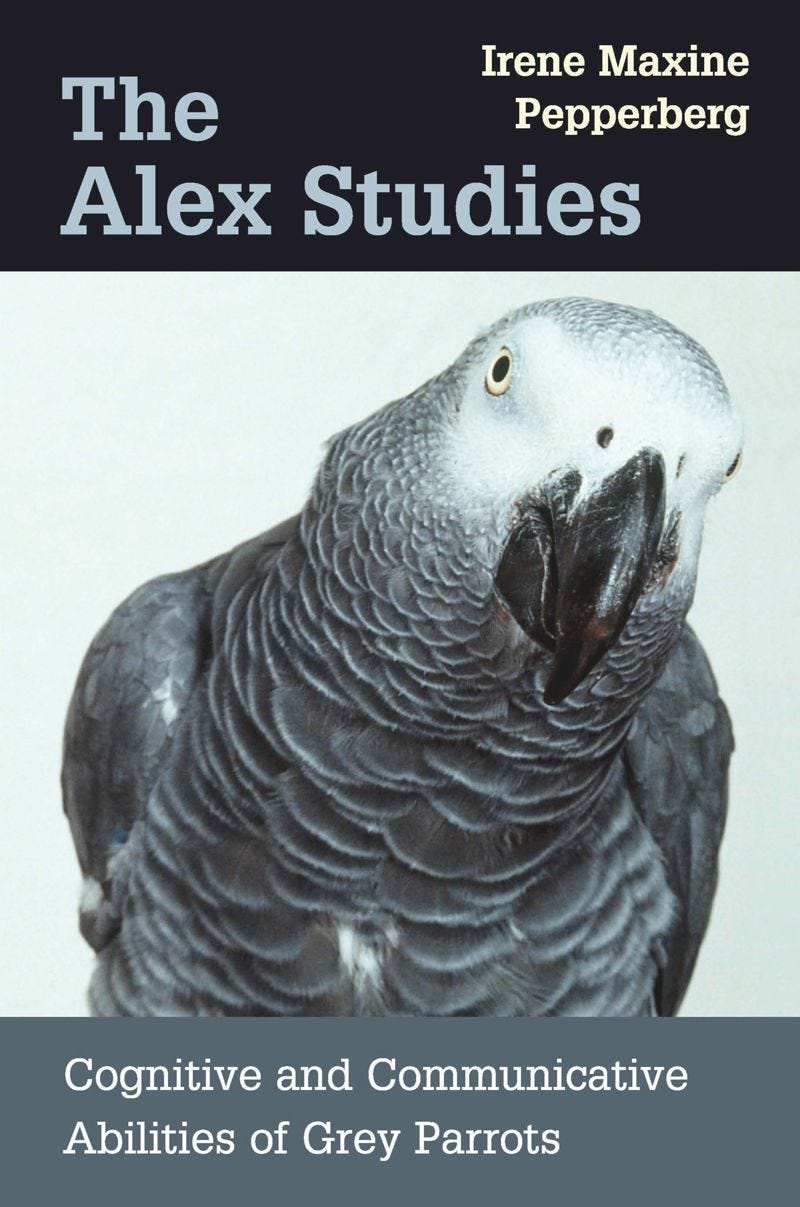
No animal has impressed me as much as Alex.
Parrots have a unique ability for vocal learning, which allows them to imitate an impressive range of sounds. Unfortunately, this natural talent is why humans have been capturing and threatening these animals, leaving some species on the edge of extinction.
But that’s not everything. For many decades, scientists thought parrots and all bird species were dumb. Why? Well, because of its brain. Birds lack the mammalian cortex but instead have a rather smooth brain. For many, the cortex was a requisite for intelligence and higher cognitive capabilities (such as reasoning and decision making).
New discoveries, especially in parrots and corvids, changed everyone’s mind.
But one of them stood out from the others.
This is the story of Pepperberg and Alex, the grey African parrot, and how they forever changed our view of birds.
How Alex And Pepperberg Met
This story begins when Irene Pepperberg, a Harvard graduate student, decided to leave chemistry to study animal behaviour.
That was a big move! Why did she do so? Well, because she was interested in studies about language in other non-human animals. At this time, scientists tried to make chimpanzees and other apes communicate like humans. However, all the attempts were unsuccessful.
Pepperberg knew that she had to choose another animal model.
That was when she decided to study parrots, particularly grey African parrots (Psittacus erithacus), as they are impressive vocal learners. So, in 1976, she went to a pet store and found a young male bird. She named him Alex. Why? Because of her project’s name: Animal Language EXperiment (ALEX).
Little did they know that they had just started one of the greatest studies of all time, which would forever change our view of birds.

Alex Learned How To Speak Human … Too Well
Pepperberg studied Alex for almost 3 decades.
During those years, she impressed science and the general public, helping to twist the view that birds are dumb. Alex learned to name objects, actions, colors, and even to request food, water, and much more.
This is how Alex talked:
Alex: ‘I want a pistachio”.
Pepperberg: ‘Okay Alex. What’s this called?’
Alex: ‘Book!’
Pepperberg: ‘Good Boy! And what’s it made of?’
Alex: *touches the bottle with his peak* “Paper!”
Irene trained Alex using the model-rival technique. Here, a human trainer interacts with the bird and another human, who is asked to complete tasks similar to Alex's. Therefore, they compete for the trainer's attention and reward. With this strategy, this bird learned many things.
For example, there was a time when Alex created a new concept.
The bird was confronted with an apple (he had no word for that). But surprisingly, he combined his understanding of the color of berries and the size of bananas to call the unnamed fruit (the apple) ‘banerry’.
Alex managed to create a new concept based on his previous knowledge!
Something thought to be uniquely human.
The Day Alex Asked What Colour He Is
For me, this was the most impressive of Alex’s behaviour.
One day, he looked in the mirror at himself and asked, ‘What colour?’ Surprised, the researcher answered with a word he had not learned yet: gray. And this is how he learned that word.
That day, Alex became the first non-human animal to ask a question.
But wait, because this parrot loved to ask. He could apply many questions to different situations and displayed frustration when answers were obviously wrong.
There was another time Alex learned how to count.
Pepperberg’s lab tested another gray parrot, Griffin, to see how many sounds could be counted. Sadly, he could not do it well and showed frustration in not understanding the task. And then the incredible thing happened:
Alex replied with all the right answers from a corner.
This genius bird was listening, paying attention, and understanding the problem.

Alex's Early Death And What He Taught Us
Pepperberg published many studies that showed the world how smart birds are.
In fact, this parrot was so smart that he was even compared to chimpanzees. How far can Alex go in his understanding of the world? Can we ask him more questions to get into his Umwelt (perceptive world) or even what it is like to be a parrot? Only time would tell.
But life had other plans for this feathered friend.
Sadly, Alex passed away in 2007 at the age of 31.
There was no way to predict this. All of a sudden, an unexpected event associated with arteriosclerosis (hardening of the arteries) caused him to die suddenly with no suffering.
Alex’s last recorded words are heart-touching:
‘You be good. I love you. See you tomorrow.’
Of course, Pepperberg and the world were devastated.
She received hundreds of letters from family, academics, and others for condolences. At that moment, Irene realized how much love and inspiration this parrot generated. She and he did change the world.
Alex forever changed the view of birds, showing how smart they are. He also inspired a new generation of scientists to study parrots, just like us.
His legacy lives in the respect, awe, and discoveries about the parrot’s life.
And other non-human animals, too.
“With a greater sense of understanding comes a greater sense of wonder”. — Anil Seth.
Until the next time,
Axel and Victoria.




